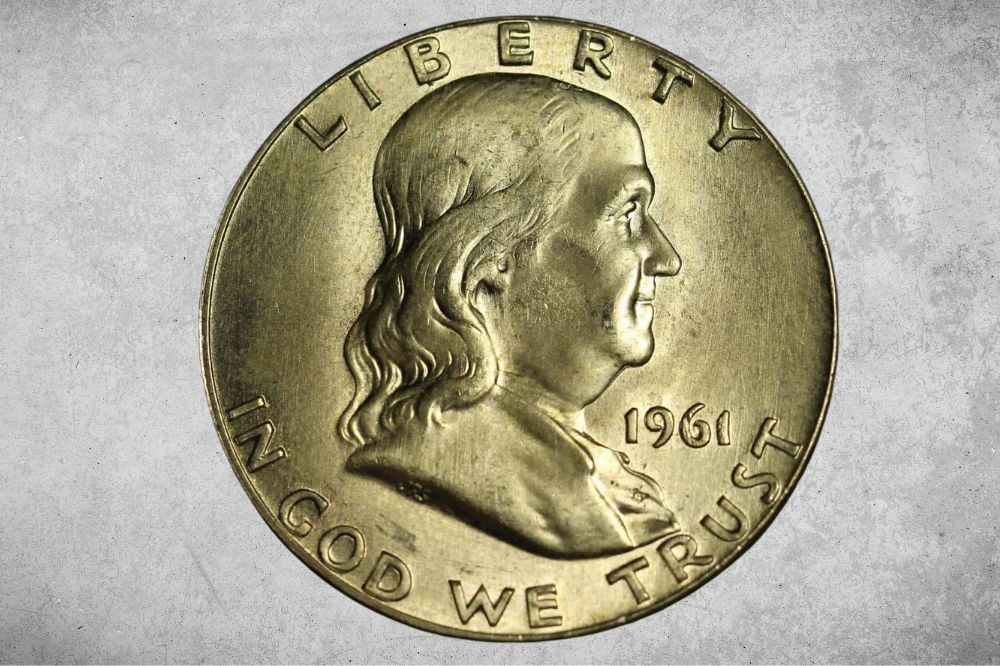The 1961 Half Dollar is a piece that should be a part of any coin enthusiast’s collection. It is an interesting coin to collect since it’s packed with a rich and notable history dating back to 1948. It has a face value of 50 cents, but its real value is far above this due to its silver content.
In our article, we’ll look into its history, varieties, the errors, and other essential details about the half dollar coin. We will also look at how these coins are graded, so sit back, relax, and let’s get started.
1961 Half Dollar Value Details
- Type: Franklin Half Dollar
- Quantity Produced: 31,594,686
- Designer: John R. Sinnock
- Edge: Reeded
- Shape: Round
- Coin Diameter: 30.6mm
- Coin Thickness: 1.8mm
- Coin Weight: 12.5g
- Year of Minting: 1961
- Mint Mark: None/D
- Place of Minting: Philadelphia, Denver
- Face Value: $0.50
- $ price: $8 – $40,800
The 1961 Franklin Half Dollars were produced by two mints: in Philadelphia and Denver. Most collectors who want to get their hands on a complete set of the Franklin series include both mints.
When looking at the coin, its design is relatively simple yet beautiful. On its obverse, an image of Benjamin Franklin is at the center, and to its right is the date.
The words “LIBERTY” are above Franklin’s image, while the inscription, “IN GOD WE TRUST,” is set along the bottom.
The coin’s reverse is slightly more complicated, where the center features the Liberty Bell. You can find “E PLURBIS UNUM” written in small text on the left, while a tiny eagle is set on the right portion. An inscription of the “UNITED STATES OF AMERICA” with a denomination is struck along its rim.
The 1961 Half Dollar is among the last dates minted for the popular series. It was generally famous due to its 90% silver content.
In 1961, more than 30 million Franklin half dollars were minted, including proof coins. This was a year when proof production rose dramatically in response to the increasing demand for proof sets from coin collectors.
However, it is good to note that there is one extremely essential variety from 1961 concerning the proof half dollars, which is 1961 doubled die reverse proof.
Franklin half dollars are not generally rare pieces. Plus, these commonly have a good supply from dealers of precious metals. Where they are rare is with perfect examples due to how often these coins were traded.
During the time of issue, the coin’s design was criticized by numerous people. It was likely due to its simple look compared to the classic Liberty Walking style. But in recent years, the Franklin half dollars became popular, and are desired by today’s numismatists.
1961 Half Dollar Coin Value Chart
| Coin Grade | Good | MS63/PR65 | MS65/PR67 | MS66/PR69 |
| 1961 Half Dollar | $10 | $25 | $100 | £800 |
| 1961 D Half Dollar | $10 | $25 | $100 | £800 |
| 1961 Proof Half Dollar | $10 | $50 | $300 | $1,500 |
1961 Half Dollar Value and Varieties Guides
The 1961 Franklin Half Dollar has at least three variants, including a proof version. The U.S. Mint branches that created the 1961 Half Dollar coin were Philadelphia and Denver.
If you inspect the coin varieties, you will not find much difference save for the mint marks. However, proof coins are known to be more attractive, have more details, and appear shinier. Here is a list of the 1961 Franklin Half Dollar varieties you should know.
1961 Half Dollar Coin
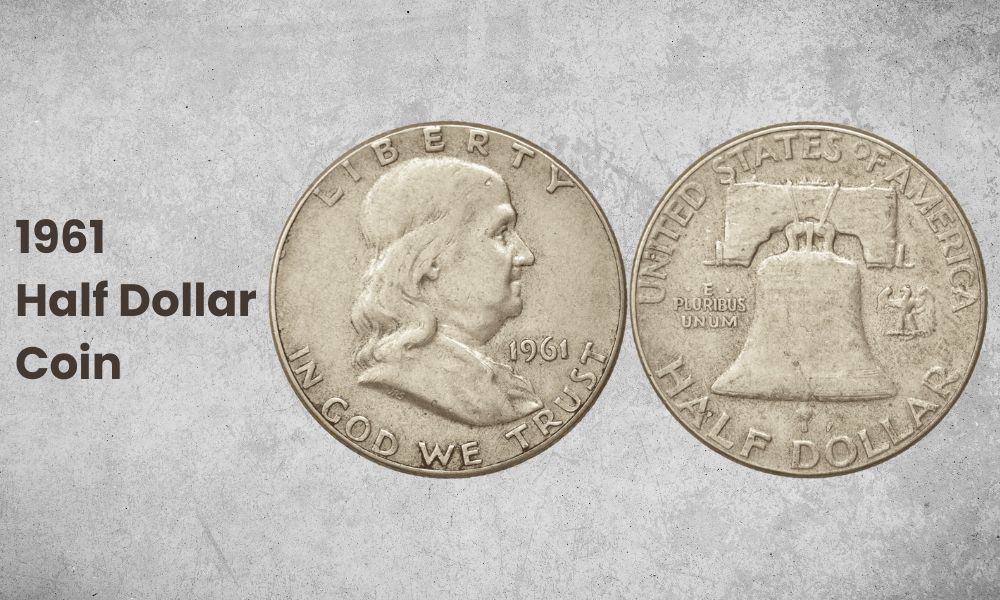
- Type: Franklin Half Dollar
- Edge: Reeded
- Mint Mark: None
- Place of Minting: Philadelphia
- Year of Minting: 1961
- Face Value: $0.50
- $ Price: $8 – $18,000
- Quantity Produced: 8,290,000
- Designer: John R. Sinnock
The Philadelphia mint was able to produce 8,290,000 Franklin Half Dollars in 1961, making them cheap and sufficient. If you plan to get these coins, you can acquire one without the mint mark in low grade. It can cost $11, while even a coin in MS65 won’t be worth over $50.
The mint is known as the only one that strikes Franklin half dollar every year of the series. A full-date run is possible of the Philadelphia version and is considered a popular collection theme.
Franklin half dollars that were produced at the mint can be identified by the absence of a mint mark. In this series, Philadelphia didn’t set any mint marks on its production.
On the coin’s reverse, you can check above the Liberty Bell just beneath the E in STATES. If there are no mint marks in that area, it confirms that the coin is a Philadelphia variety.
MS67 coins are extremely rare, especially when compared to many other coins from around this time. Due to the silver content, it seems as though many people had more consideration for the value of silver rather than the value of a perfect coin. MS66 coins will often sell for around $800.
1961 D Half Dollar Coin
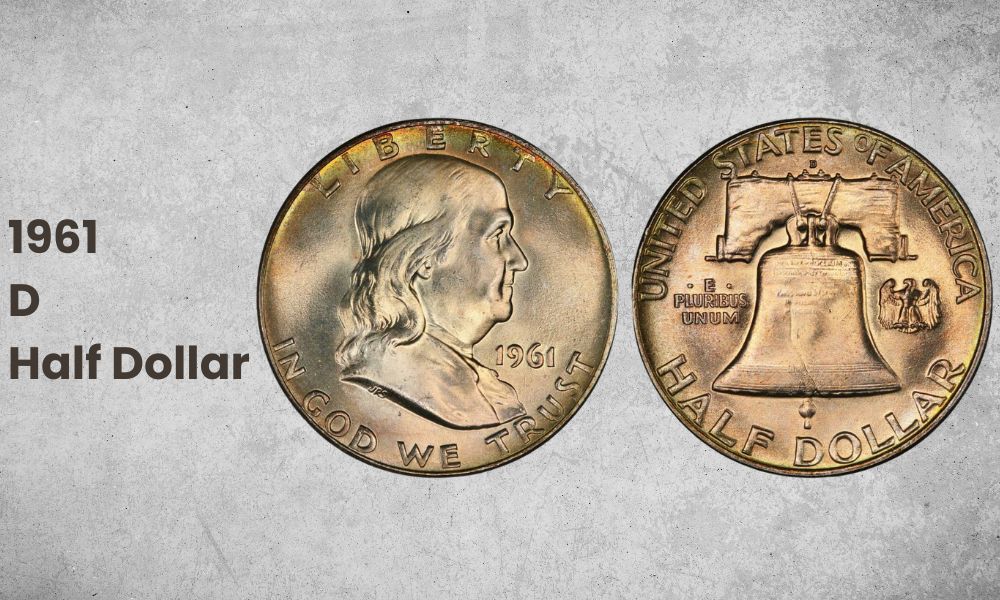
- Type: Franklin Fifty Cents
- Edge: Reeded
- Mint Mark: D
- Place of Minting: Denver
- Year of Minting: 1961
- Face Value: $0.50
- $ Price: $8 – $18,000
- Quantity Produced: 20,276,442
- Designer: John R. Sinnock
Today, the Denver variety of 1961 Franklin half dollars is abundant in numbers. A considerable 20.2 million coins were produced, and plenty of these was preserved in all conditions. Coins that circulated and ended up worn were traded according to their value of silver content.
All Franklin half dollars have 90% silver and are worth well above its 50-cent face value. In collector’s quality (coins without wear on their surface), adequate supplies are available.
Collectors search for coins in high condition, and the market enjoys premiums higher than silver’s worth.
You can identify the Denver variety by a D mint mark on its reverse. Right above the Liberty Bell, if you find a D on that spot, the Denver mint produced the piece.
As with the Philadelphia coins, you can expect MS66 versions to sell for around $800. However, in the extremely rare instance of finding a PR67 coin, they can sell for much higher. The record is $18,000, which happened in 2019, but these coins often sell for over $5,000 if they have full FBL (Franklin bell lines).
1961 Proof Half Dollar Coin
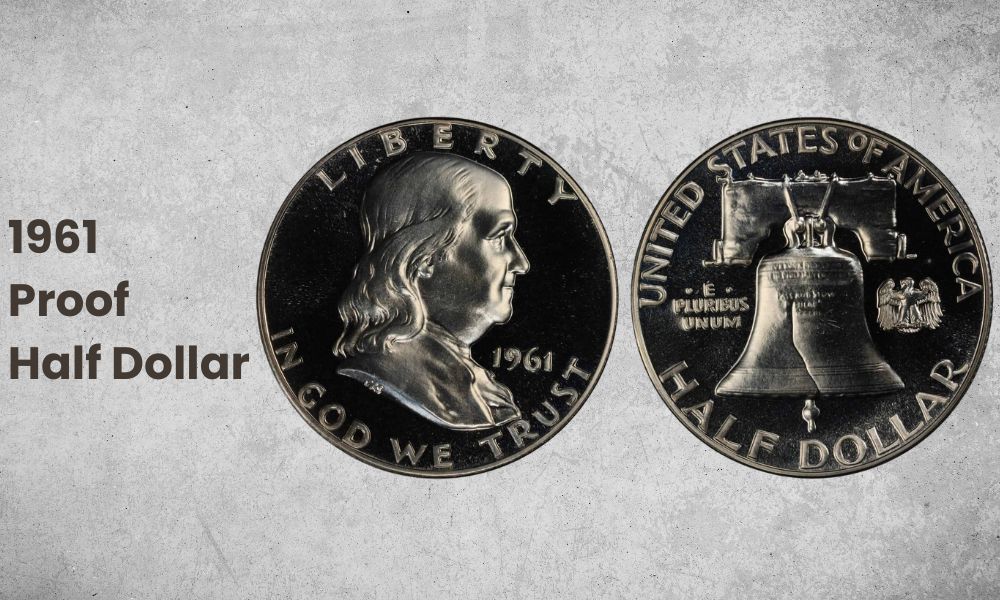
- Type: Franklin Fifty Cents
- Edge: Reeded
- Mint Mark: None
- Place of Minting: Philadelphia
- Year of Minting: 1961
- Face Value: $0.50
- $ Price: $8 – $40,800
- Quantity Produced: 3,028,244
- Designer: John R. Sinnock
When we speak of proof coins, these are produced in a different manner. Its die is struck with more force to bring out a more detailed appearance.
Mostly, its planchet is struck two times. This is why the 1961 half dollar proof coins are shinier, more detailed, and physically beautiful. However, it’s expected that these coins are in excellent condition, so only the best examples sell for high prices.
The 1961 Franklin half dollar proof coins are the more common pieces from the series. These were also similar to the Franklin half proofs struck from 1960 to 1964. Samples that showcased full cameo and deep cameo surfaces are rarer and require higher premiums.
In 1961, the Philadelphia mint struck an interestingly high number of proofs totaling 3,028,244. Most pieces are worth $25 to $80. However, you need to pay around $600 for a top-quality sample in PR69 grade.
That price will go even higher for a deep cameo coin, with a price of $1,500 expected. But it can go even higher than that. The auction record for a 1961 proof coin is a mind-blowing $40,800.
1961 Half Dollar History
The U.S. Mint struck liberty bell Franklin half dollars from 1948 to 1963. The series featured Benjamin Franklin, one of the Founding Fathers, on its obverse.
Senior engraver John Sinnock designed a half dollar with Franklin. However, he was unable to complete the project due to his death, but fortunately, it was continued and completed by Gilroy Roberts.
The first idea was to put Benjamin Franklin on the coin after his famous quote, “a penny saved is two pence clear”. But the Mint director of that time, Nellie Ross, thought such a significant individual deserved a silver coin. So, Sinnock took inspiration for his design from the work of Jean-Antoine Houdon, who had sculpted a bust of Benjamin Franklin.
The Liberty Bell was included, which was a natural option since it was also associated with Franklin and the country’s founding.
At first, Sinnock’s initials, JS, were placed on the coin. But due to controversies and issues, all his three initials had to be placed instead (JRS). Back then, some conspiracy theorists assumed that the initials referred to Joseph Stalin, which was an issue during the Cold War.
On the 22nd of November in 1963. John F. Kennedy was assassinated, so Congress and the Mint got into action to authorize and create a half dollar to give tribute to him.
On December 30, 1963, the Kennedy half dollar was authorized, leading to the end of the Franklin half dollar series.
Half Dollar Grading
You may look at your 1961 half dollar and think that it’s in good condition, but in reality, it’s incredibly difficult to get a coin rated in the higher grades. Coins are rated from 1-70, and it’s only in the very last few grades that they will be valued above the coin’s melt value.
MS (mint state) is used for circulated coins, and PR is used for proof coins. For example, an MS60 coin may look in great condition to the untrained eye, but it wouldn’t be worth much.
List of 1961 Half Dollar Errors
There were more than 31.5 million Franklin Half Dollar coins produced in 1961 by the U.S. Mint. Because of so many coins created, it’s not a surprise to find some pieces with errors on them.
Errors on coins are unintentional, yet interestingly, coin collectors are more than willing to purchase and get their hands on error pieces. Why? Because error coins can be valuable due to their unique condition and rarity.
There are various reasons why errors happen, including die, planchet, and mint striking errors. All of these are linked to the wear and tear of the minting equipment. Here are the errors seen from the coin series:
1. Doubled Die
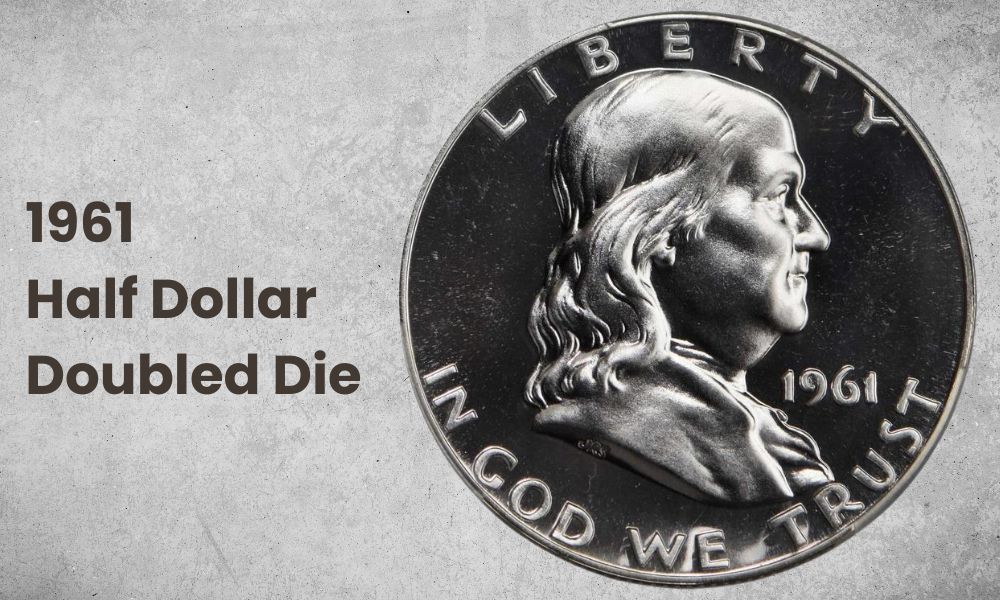
It is quite a surprise to find a rare, unique, and high-priced coin among the less expensive modern proof collections. This is the doubled die reverse proof franklin half dollar.
Doubled dies to happen when the design and style elements on the coin get doubled. When this happens, the coin ends up looking like it was struck twice.
This is very notable because the proofs need to be created to an exact or perfect standard. However, the mirrored surfaces highlight the misaligned display of the double die reverse.
There are multiple minor versions of this type with slight doubling. However, the rarest and most popular piece is extremely visible to the naked eye.
Sometimes, these errors cannot be easily detected, and you’ll need an appraiser to help. They will use a magnifying glass to check the coin for the doubled die error. Just remember, if the doubled die error is more obvious, then the higher the price of the coin.
2. Die Error
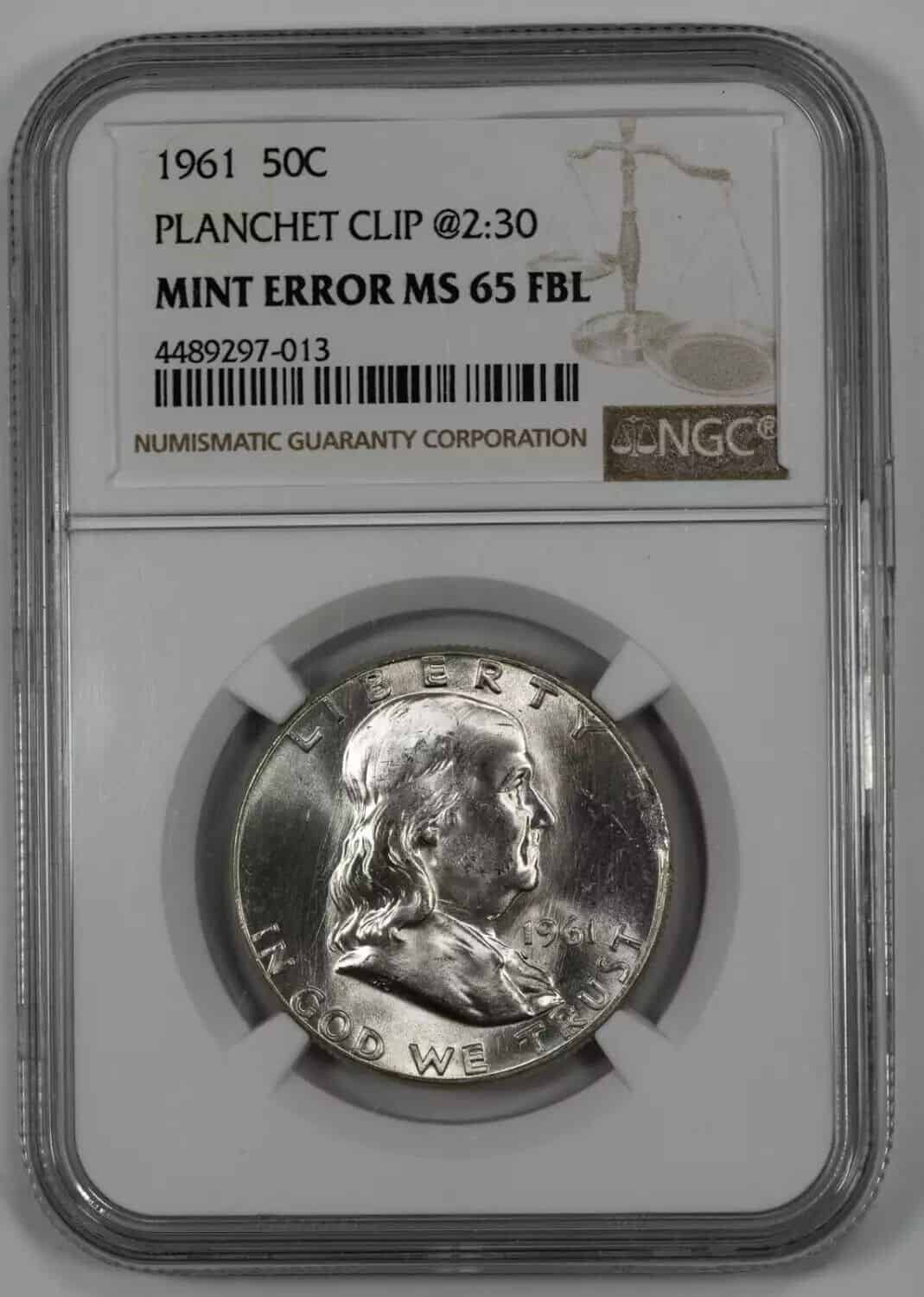
The next issue is the die error. Here, the die strikes the planchets several times, which could cause the die to break.
Cracks can be found in a broken die, leaving marks on the coin when it strikes the planchet. The piece isn’t properly cut due to planchet errors, and these could have clipped edges or could be too thick/thin.
1961 Half Dollar FAQs
1. How much is a 1961 half dollar coin worth?
As of early 2023, it is claimed that a 1961 Franklin half dollar in circulated condition is between $8 and $11 due to the price of silver. But on the open market, a 1961 half dollar in pristine and uncirculated condition can sell for thousands of dollars.
2. What Year is the Rarest Half Dollar?
The rarest half dollar is the 1964 SP 68 Kennedy Half Dollar. In 2019, one piece of this specific coin sold for $108,000 at the Heritage Auctions. And for its coin type, it won an auction record. The auction record for a 1961 half dollar is $40,800
3. What is a 1961 Half Dollar Made of?
The 1961 Half Dollar is made of mostly silver. The 90% silver content makes this a valuable coin in its own right. However, the other 10% is made from copper, which has also seen a price surge in the last few years.
4. How Can You Tell if a Half Dollar is Rare?
One of the best and easiest ways to determine if your half dollar is rare is by inspecting the coin’s edge. If you see a bright copper strip encircling the coin’s edge, it means you only have a regularly struck coin. If you think your coin is in perfect condition, then it’s a good idea to get it appraised.
